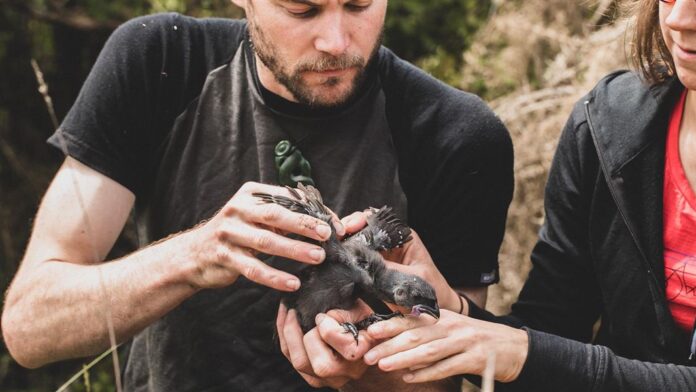Source: Department of Conservation
Date: 08 April 2021
The Pirongia Te Aroaro O Kahu Restoration Society (PRS) has almost completed its annual kōkako nest monitoring after a season of dedicated birdwatching and nest-minding that began in September 2020. There have been nine pairs this season, each incubating and rearing at least one clutch of chicks and, in the case of one pair, three clutches.
The main threats to eggs and chicks are ship rats, possums and mustelids. For the population to persist, pest management is needed. Birds disappeared from the maunga in the 1990s due to pests; however, following extensive pest management, 20 birds were translocated by the PRS back in 2017, and a further 14 in 2018.
Dave Bryden and Amanda Rogers, kōkako ecologists working with the PRS, headed into the predator control area to locate pairs in October.
“Pairs are identified using song playback,” says Amanda Rogers. “Recordings of the birds are played in the forest at 200m intervals. If the birds have paired up, they’ll be defending a territory and will investigate the song.”
When a pair is identified, the ecologists watch closely for nesting behaviours: birds carrying sticks, moss, fern fronds, and beak-to-beak courtship feeding. A female might also disappear into the tree for a long period of time.
But not all birds are lucky in love.
“In Pureora Forest Park a majestic male kōkako was caught for translocation to Pirongia in 2018. He weighed 283g (a small adult is 190g) so he’s really big,” says Clare St Pierre, Chairperson of the PRS.
The big male bird, aptly named Pavarotti, has been seen with three females and has attempted a duet with two. “Unfortunately, Pavarotti hasn’t yet found ‘the one’. We’re hoping he finds true love next season.”
Once a nest has been identified, a schedule is drawn up and every four days a PRS volunteer checks on a nest for an hour, recording the birds’ behaviour.
“Within 60 minutes you should be able to see parents feed the chicks. If the female is incubating, the male will usually feed her every 20 – 30 minutes” says Amanda Rogers. “You can gauge the age of the chicks by how frequently they need to be fed, and whether they need to be brooded for warmth or if they have their own feathers.”
Volunteers also set traps around the base of the nesting tree, says Clare St Pierre.
“We set 20 rat traps and one to two possum traps and check them every four days. We reset and re-bait, as necessary. Rats and possums have been caught, so it is necessary.”
Department of Conservation (DOC) Biodiversity Ranger, Cara Hansen, works closely with the PRS providing technical advice and support.
“The PRS is doing fantastic work on the maunga” says Cara. “Including 1,300 hectares of annual pest control, which DOC supplements with landscape-scale pest control across the entire 12,500 hectares of forest. It’s making a difference, and the birds are evidence of that.”
Fledging day is long anticipated by all. It’s when a young bird, encouraged by its parents, wanders off the nest and takes its first daring leap off the branch. When it makes the leap, there is a sense of personal accomplishment.
“There are a lot of people giving up their time to do this work,” Clare St Pierre says. “We wouldn’t be having this success without our more than 100 volunteers, trappers, ecologists, and support from DOC and iwi”
The PRS has a set up a pest control grid across the maunga, including Mangakara, Mangaio, Mangamauku, Mangawawa and Ruapane. It welcomes new members to help with any number of its projects, including kōkako nest monitoring.
More information about Mount Pirongia Restoration.
Minister of Conservation Kiritapu Allan recently announced a significant population milestone in ongoing efforts to recover the North Island kōkako.
Announcement about milestone for kōkako as population soars.
Contact
For media enquiries contact:
Email: media@doc.govt.nz



